Honor Award
San Mateo County Sustainable Green Streets and Parking Lots Design Guidebook
Nevue Ngan Associates, Portland, OR
Client: City/County Association of Governments of San Mateo County, CA
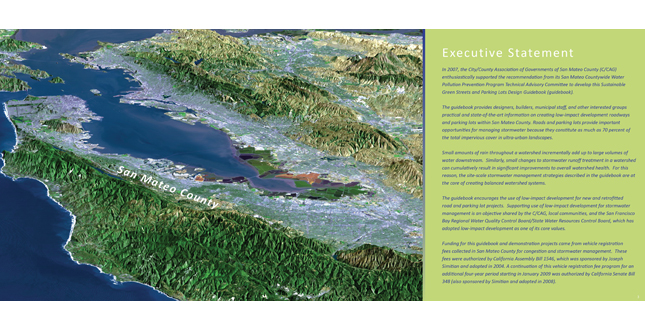 Close Me!
Close Me!The purpose of the design guidebook is to help the user identify and realize various green street and parking lot retrofit opportunities, provide solutions to common implementation barriers, and provide guidance on how to best design, construct, and maintain successful projects. The guidebook serves to educate, inspire, and promote innovation.
Download Hi-Res ImageImage: Nevue Ngan Associates
Image 1 of 15
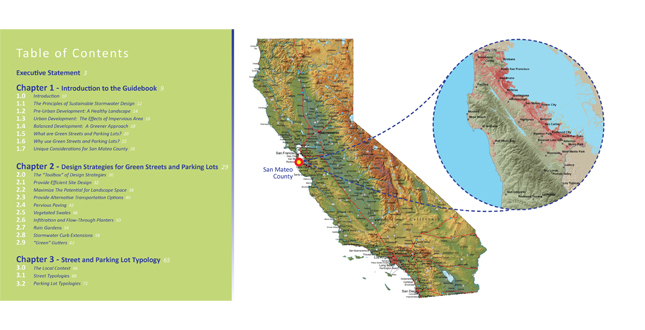 Close Me!
Close Me!The first three chapters of the design guidebook introduces the user to the guidebook, proves the design strategies for green streets and parking lots, and illustrates typical street and parking lot typology in San Mateo County.
Download Hi-Res ImageImage: Nevue Ngan Associates
Image 2 of 15
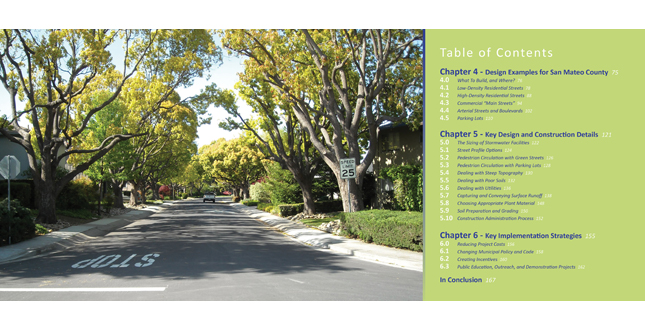 Close Me!
Close Me!The final three chapters of the design guidebook applies design strategies to specific street and parking lot types, provides key design and construction details, and outlines various implementation strategies for green streets and parking lots.
Download Hi-Res ImageImage: Nevue Ngan Associates
Image 3 of 15
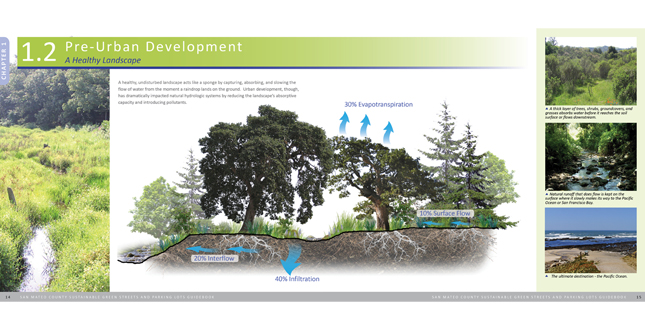 Close Me!
Close Me!This illustration shows, in basic terms, the hydrologic conditions found in the natural environment prior to urbanization. Sustainable stormwater design tries to mimic this condition to the best extent possible.
Download Hi-Res ImageImage: Nevue Ngan Associates
Image 4 of 15
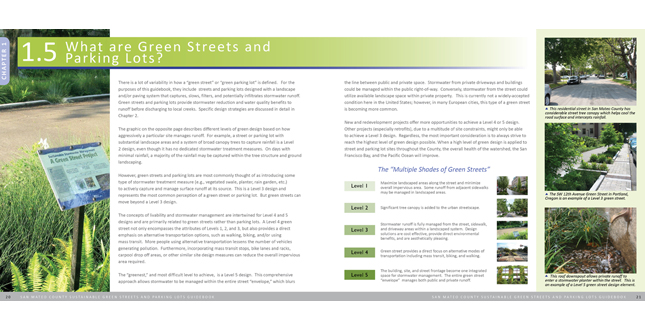 Close Me!
Close Me!There is a lot of variability in how a “green” a street really is, and all green streets are not created equal. Some streets, and in some cases, individual blocks of a street can vary on how aggressive the green street approach is.
Download Hi-Res ImageImage: Nevue Ngan Associates
Image 5 of 15
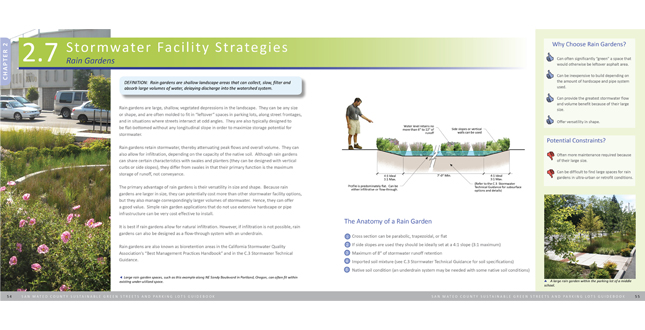 Close Me!
Close Me!Stormwater facilities such as vegetated swales, infiltration and flow through planters, rain gardens, stormwater curb extensions, green gutters, and pervious paving, are detailed in the design guidebook.
Download Hi-Res ImageImage: Nevue Ngan Associates
Image 6 of 15
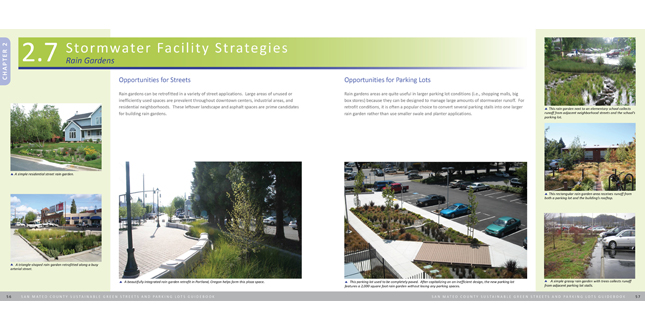 Close Me!
Close Me!Hundreds of photos of built green street and parking lot projects are included within the design guidebook to give the reader the full spectrum of design possibilities.
Download Hi-Res ImageImage: Nevue Ngan Associates
Image 7 of 15
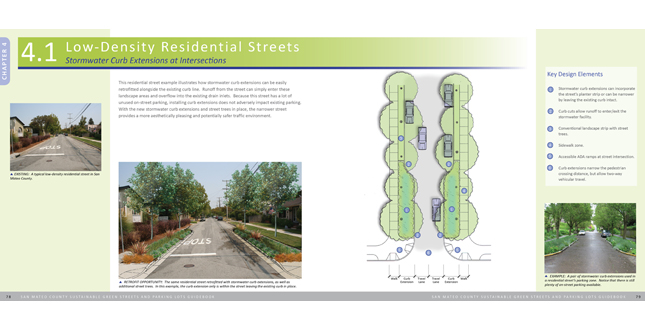 Close Me!
Close Me!This residential street shows the potential to be retrofitted with stormwater curb extensions, as well as additional street trees. In this example, the curb extensions only are within the street leaving the existing curb in place.
Download Hi-Res ImageImage: Nevue Ngan Associates
Image 8 of 15
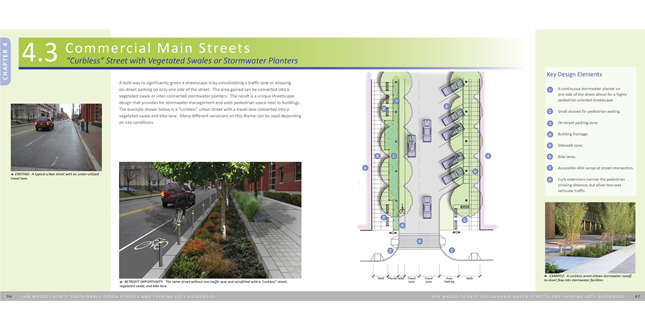 Close Me!
Close Me!This commercial main street illustrates how an under-utilized travel lane can be consolidated into a vegetated swale or planter as well as introducing a bike lane. This design example also showcases a "curbless" street profile.
Download Hi-Res ImageImage: Nevue Ngan Associates
Image 9 of 15
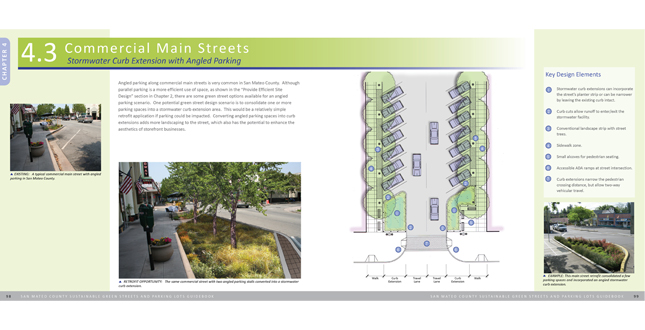 Close Me!
Close Me!By removing just a few parking spaces along this commercial main street and introducing stormwater curb extensions, runoff can be effectively managed and the entire street character can be enhanced.
Download Hi-Res ImageImage: Nevue Ngan Associates
Image 10 of 15
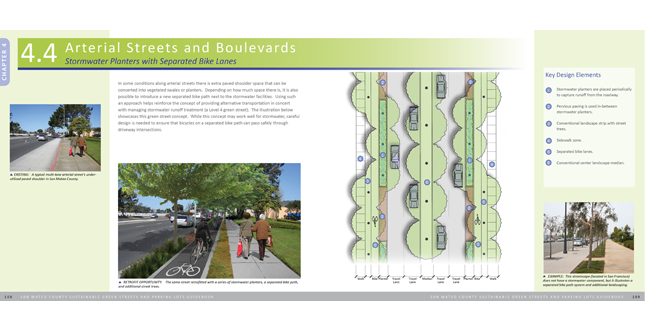 Close Me!
Close Me!In a bold move, the under-utilized should of El Camino Real has the potential to be completely transformed into a series of stormwater planters and a separated bike lane.
Download Hi-Res ImageImage: Nevue Ngan Associates
Image 11 of 15
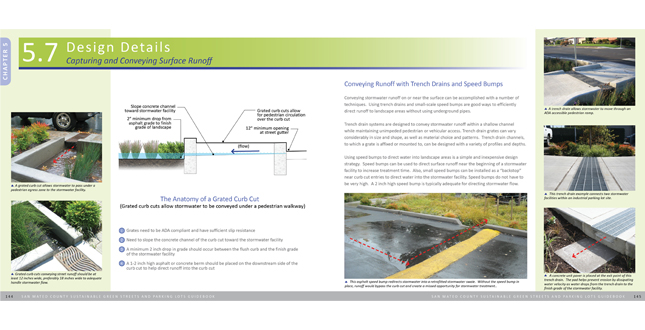 Close Me!
Close Me!In Chapter 5, the guidebook discusses nearly 20 key design and construction details for green streets and parking lots. This example illustrates various ways runoff can be conveyed to stormwater facilities.
Download Hi-Res ImageImage: Nevue Ngan Associates
Image 12 of 15
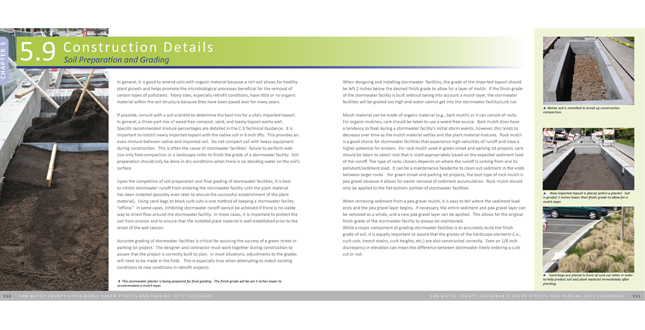 Close Me!
Close Me!Soil preparation, site grading, and other key construction administration considerations are detailed within the design guidebook.
Download Hi-Res ImageImage: Nevue Ngan Associates
Image 13 of 15
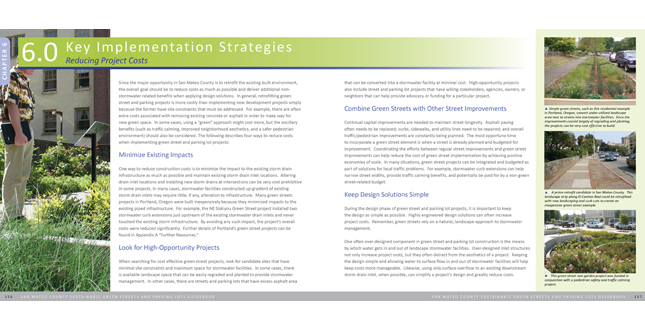 Close Me!
Close Me!Going beyond the design realm, Chapter 6 provides information on implementation strategies such as reducing project costs.
Download Hi-Res ImageImage: Nevue Ngan Associates
Image 14 of 15
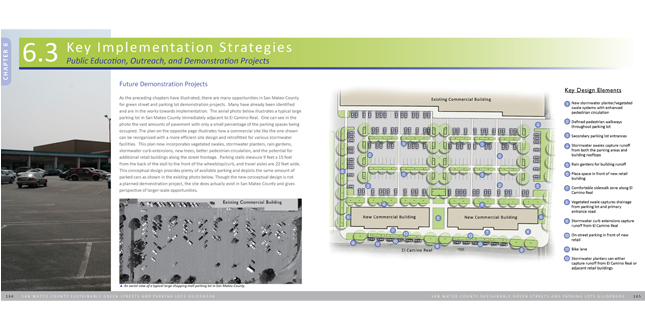 Close Me!
Close Me!By integrating the multiple strategies described within the guidebook, this existing strip mall in San Mateo County has the potential to be completely transformed into a vibrant and "green" retail center.
Download Hi-Res ImageImage: Nevue Ngan Associates
Image 15 of 15
Project Statement
Completed in January 2009, the San Mateo County Sustainable Green Streets and Parking Lots Design Guidebook is a 167-page document that richly illustrates how streets and parking lots can be designed to manage urban runoff in a more sustainable and natural way. The design guidebook provides a bold, clear, and “green” vision for 21 municipalities within San Mateo County, California, and is regarded as one of the most innovative and comprehensive guidance documents on green street design in the nation.
Project Narrative
—2011 Professional Awards Jury
In December 2007, the San Mateo Countywide Water Pollution Prevention Program (SMCWPPP) initiated measures to address the detrimental impacts of stormwater runoff from transportation infrastructure on County waters. The initial measure involved creating a grant program that uses vehicle registration fees to fund the construction of stormwater demonstration projects within the County.To complement this effort and to assist San Mateo County municipalities with designing green street and parking lot demonstration projects, the landscape architect was commissioned by the SMCWPPP to produce the San Mateo County Sustainable Green Streets and Parking Lots Design Guidebook. In general, the guidebook is intended to inspire small but widespread changes that will improve San Mateo County’s watershed health. The more specific purpose of the guidebook is to help the user identify and realize various green street and parking lot retrofit opportunities, provide solutions to common implementation barriers, and provide guidance on how to best design, construct, and maintain successful projects. The guidebook serves to educate, inspire, and promote innovation.
Education
The early chapters of the guidebook provide a basic discussion on the principles of sustainable stormwater design, highlight why better site-scale stormwater strategies are needed in San Mateo County, define green streets and green parking lots, and illustrate the unique conditions found in San Mateo County as they relate to stormwater management. The landscape architect details a series of site layout and stormwater design strategies that formulate a tool box for green street and parking lot design. The intent is to encourage the user of the guidebook to think beyond “the grassy swale” and provide designers, builders, and municipal staff with a wide array of design options to choose from when retrofitting streets and parking lots in highly urban conditions.
Inspiration
The San Mateo County Sustainable Green Streets and Parking Lots Design Guidebook contains nearly 400 drawings and photographs pertaining to green street design and implementation and uses this imagery to inspire green street projects throughout San Mateo County. Chapter 4, considered the most powerful section of the guidebook, illustrates a series of “before and after” sketches and plan view renderings of green street and parking lot retrofit opportunities applicable to a wide variety of conditions in San Mateo County. Whether a particular site is located in a low or high-density residential neighborhood, a commercial “main street” district, along an arterial or boulevard street, or within a small or large parking lot, the guidebook provides a bold vision of what sustainable stormwater design could look like in San Mateo County.
Innovation
In addition to providing visual inspiration, the landscape architect was also asked to provide practical insight on how to successfully implement green street and parking lot projects. Chapter 5 of the guidebook provides a detailed discussion of the key design and construction details that can often prove problematic in building green street projects. Lastly, Chapter 6 of the guidebook goes beyond the design realm and presents how to best implement green streets and parking lots from a policy or programming perspective, such as identifying ways to reduce construction costs, creating incentive programs, and describing different approaches for developing demonstration projects.
Project Impact and Effectiveness
The San Mateo County Sustainable Green Streets and Parking Lots Design Guidebook has been recognized both locally and nationally. The design guidebook has earned the 2009 California American Planning Association’s “Innovation in Green Community Planning” Award of Excellence. Nationally, the guidebook is considered a leading reference in green infrastructure by multiple federal and state agencies as well as local municipalities within throughout the United States. Though the San Mateo County Sustainable Green Streets and Parking Lots Design Guidebook has proven to be a highly successful planning and design tool, it is the communicative value of the guidebook that has been truly impressive.
Within the last two years, the landscape architect has been invited to present the guidebook to various national audiences and has conducted green infrastructure workshops in several states including: Florida, Connecticut, Washington, and California. These interactive workshops have allowed landscape architects, engineers, planners, policy makers, and public officials to come together and gain a better understanding of the guidebook and how to apply what they have learned to their own communities. The crescendo of these workshops is having the landscape architect lead participants in a half-day design charrette that retrofits locally-selected project sites with the strategies presented within the design guidebook. In addition, the landscape architect was honored to present the design guidebook in Washington D.C. at the 2010 ASLA Annual Meeting.
The San Mateo County Water Pollution Prevention Program has a dedicated website for their Green Streets and Parking Lots Program. In an effort to conserve natural resources, the design guidebook has been digitally formatted and posted on the website and is available for immediate download. Visitors to the website can download the entire document, individual chapters, or specific topic sections depending on their interests. Since January 2009, thousands have downloaded the design guidebook and hundreds of people have attended green infrastructure workshops. In addition, a 2-hour video of the May 2009 Green Streets and Parking Lots Workshop in San Mateo County has been posted on online. Hence, the guidebook can be accessed in its original graphic form, in-person via workshops, or by video link.
In an effort to keep to its pledge of innovation, the San Mateo County Sustainable Green Streets and Parking Lots Design Guidebook has recently had its format and graphics updated to better communicate the content of the guidebook and to provide the most up-to-date photographs of green street and parking lot design options.
In conclusion, the San Mateo County Sustainable Green Streets and Parking Lots Design Guidebook has proven to be a valuable resource for those looking for a clear and visionary guide on green street and parking lot design. However, we believe that the most significant impact the guidebook has made is demonstrating how landscape architects are taking an immediate and leading role in helping communities realize their vision in the planning, design, and implementation of green infrastructure.
Project Resources
Lead Designers:
Kevin Robert Perry, ASLA, Olena Turula, Jason Hirst
Local Civil Engineering Support:
Sherwood Design Engineers
Robert Dusenbury
Guidebook Technical Review
Karen Borrmann, City of Belmont
Elizabeth Claycomb, City of Pacifica
Matthew Fabry, City of Brisbane and SMCWPPP Program Coordinator
Jane Gomery, City of Burlingame
Fred Jarvis, EOA, Inc.
Rosey Jencks, San Francisco Public Utilities Commission
Jeannie Naughton, City of Daly City
Laura Russell, City of San Bruno
Gilbert Yau, City of Belmont






